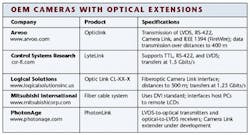Standards-based cameras find optical extensions
In a clean environment, digital video using a standard RS-644/LVDS output format can be transmitted over cables for about 30 m. For Camera Link interfaces, this distance shortens to approximately 10 m, and for IEEE 1394 (FireWire) interfaces the distance shrinks to about 4 m. Using standard cables to extend this distance can result in transmission errors depending on the system environment and the data clock frequencies. Now, designers of standards-based machine-vision systems can extend the distance of their camera-to-frame-grabber interfaces, thanks to a range of products from several companies (see table).
For example, Arvoo (Montfoort, The Netherlands), Logical Solutions (Milford, CT), and PhotonAge (Fremont, CA) offer Camera Link extension products. The Arvoo Opticlink product supports transmission of LVDS, RS-422, Camera Link, and 1394 FireWire interfaces over optical fiber. Offering a digital-video transparent channel for use with most cameras and frame grabbers, the Opticlink system consists of two transceivers. The first transceiver interfaces the standards-based camera signals to a fiberoptic transmitter. The second transceiver converts the optical signals back to the camera signals. Because most Arvoo products come with multimode optical fiber, data transmissions over distances to 400 m are possible. By using single-mode optical fiber, data transmission can operate over distances to 40 km.
Logical Solutions has also developed fiber-based extension products for Camera Link. Its Optic Link CL-XX-X fiberoptic interface device consists of an integrated Camera Link-to-fiberoptic transceiver and a fiberoptic-to-Camera Link transceiver. With a supply voltage of 5 V, the device's USB-like connectors feature both an integrated MDR26 Camera Link interface and a fiberoptic interface. Featuring Camera Link Base-configuration support, the interface can extend camera-to-frame-grabber distances to 500 m, according to John Thomas, vice president of sales. The dual stand-alone transceivers can transfer data as fast as 1.25 Gbits/s over optical fiber.
Recently, the company demonstrated a fiber-based extension system using a CV-M4-CL Plus, monochrome 1392 × 1040-pixel resolution camera from JAI America (Woburn, MA; www.jai.com) running at 24 frames/s. Interfaced to the Logical Solutions CL-20-R Optic Link Riser, data from the camera are transmitted over distances to 20 m, where the data are captured by a PC using the Road Runner CL Camera Link frame grabber from Bitflow (Woburn, MA; bitflow.com). After the images are captured, they are transmitted another 20 m using a DVI interface on an ATI Technologies (Markham, ON, Canada; www.ati.com) Radeon 7500 AGP video card over the Logical Solution DVI-R-20 Riser. Images are then displayed at full resolution on an SDM-M81 TFT liquid-crystal display from Sony Electronics (Park Ridge, NJ; www.sony.com).
PhotonAge provides a PhotonLink Optical Interface as an integrated camera-to-data transmission platform using plastic optical fiber. It also offers several products that include LVDS-to-optical transmitters and optical-to-LVDS receivers. The company is seeking remote LCD-panel applications and a data-transfer mechanism in portable computer applications. For the machine-vision market, it will roll out a Camera Link extender, dubbed Clextender, which will extend camera-to-frame-grabber distances to hundreds of meters.
Andrew Wilson, Editor, [email protected]

